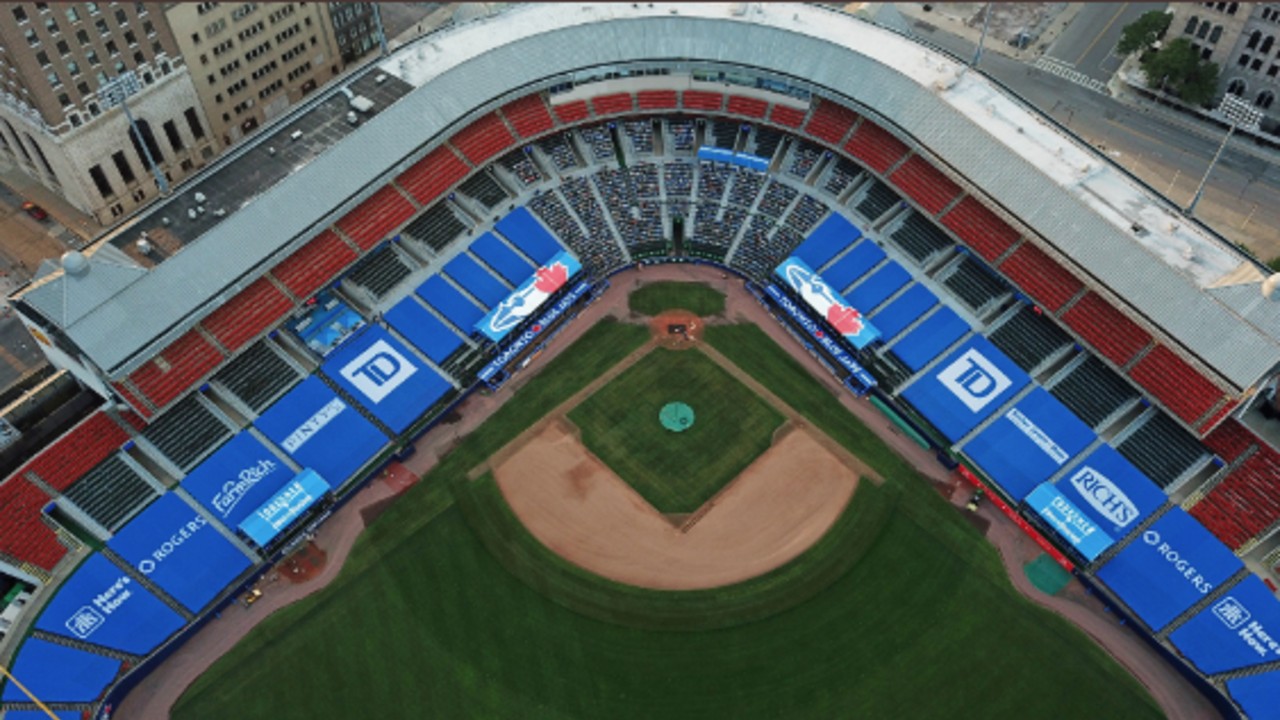Marnie Starkman, the senior vice president of marketing and business operations for the Toronto Blue Jays, is only one of 25 club personnel that have been on the ground in Buffalo, N.Y., for the last two weeks, furiously working to transform Sahlen Field from a minor-league facility to something resembling a major-league one.
She’s working with individuals from across the organization’s many departments including baseball operations, information and technology, fan services, and even the grounds crew head from the club’s spring training site in Florida. The substantial upgrades undertaken in Buffalo are the result of a massive team effort, and Starkman doesn’t feel particularly comfortable taking credit for any of it.
“Our team down here has done a ton of work — I’m crazy proud of what we were able to put together for our guys in trying to make Buffalo the best home possible for hopefully 27-plus games,” she said Monday, as the Blue Jays unveiled their home ballpark for the 2020 season. “These are plans that normally would have taken a year. I keep joking with everyone — it’s like the worst imaginable fan fest, putting it together in two weeks. That’s what it feels like. So, as much as we had plans and drawings, there’s a ton of things that come up as you do this.”
Good Morning from Sahlen Field! #WeAreBlueJays pic.twitter.com/DDDBrTKmt8
— Toronto Blue Jays (@BlueJays) August 10, 2020
Those plans and drawings began with MLB and BaAM Productions, a Toronto-based production company that has worked on NHL Winter Classics and MLB fan festivals. The operations manual BaAM created in anticipation of staging a regular season game this summer at the Field of Dreams site in Dyersville, Ia., was shaped and modified to be applied to Sahlen Field.
The Blue Jays also borrowed heavily from the Boston Red Sox, after observing how they creatively optimized limited space at 108-year-old Fenway Park, utilizing concourses and suites to house training facilities and locker rooms.
“The Red Sox have been fantastic,” Starkman said. “What they did with space really gave us creativity in how we could use the concourse. They were great in sharing their plans.”
It’s all in the details
Your first inside our home away from home! #WeAreBlueJays pic.twitter.com/d3bqJUP9GD
— Toronto Blue Jays (@BlueJays) August 10, 2020
MLB’s 2020 Operations Manual lays out an extensive list of health and safety standards to be observed within club facilities, including distancing guidelines, cleaning procedures, and limits on the number of people who can be in certain areas at certain times.
Player and coach lockers must have at least six feet of space between them. Weight room occupancy is capped at one individual for every 36 square feet. Recovery equipment such as hydrotherapy and cryotherapy units are to be used by only one person at a time.
As things stood in Buffalo prior to the upgrades, the home clubhouse could accommodate at most 15 players while following the protocol. The visiting clubhouse could hold only 10. Combined, that’s not enough for one 28-man roster, let alone a coaching and support staff of more than 20.
“Once we realized space was an issue, MLB had that plan for what a big clubhouse looked like because they were dealing with Field of Dreams,” Starkman said. “So, that really helped us.”
And here are some before/after pics, all via the @BlueJays pic.twitter.com/neOEB7EKTl
— Ben Nicholson-Smith (@bnicholsonsmith) August 10, 2020
Within the home clubhouse, the Bisons locker room is now the coaches’ locker room. A small meeting room has been transformed into Charlie Montoyo’s office. The Bisons weight room has been repurposed as a rehabilitation and recovery area. Washrooms have been refreshed with new paint and signage, and modified to encourage distancing.
The Blue Jays locker room is laid out through the stadium’s service level, overtaking spaces where indoor batting cages once stood. Players will each have a freestanding metal locker with several feet of distance on either side. A small pre-game stretching area leads to a long tunnel players will use to access the dugout. An additional HVAC system has been added to ensure proper circulation.
The Blue Jays shipped four full moving trucks of furniture and equipment across the border in order to maintain as much consistency as possible with the facilities players were used to at Rogers Centre. Weights, cardio equipment, clubhouse chairs and training tables all made the trip. As did the congas and family photos from Montoyo’s office.
“It was kind of a cool moment just watching [Montoyo] walk in last night,” Starkman said. “Anything we could do to make it feel a little homey, we tried to do.”
Sahlen Field’s main concourse is now a training area with squat racks and treadmills taking over the spaces where fans once lined up to buy hot dogs and beer. Several batting cages line the concourse, as well — black netting encasing tees and pitching machines sitting atop temporary turf.
Visiting clubs will set up shop in a large, tented structure purpose-built beyond the right-field fence. The essentials are all there in one way or another, but it will be far from the level of luxury MLB players and staff are accustomed to.
Within the main tent, each player has a modest locker and chair around the corner from the same plumbed washrooms and shower stalls that were going to be used at the Field of Dreams setup. There’s open-air gym space, an indoor and outdoor batting cage, and a small trainer’s room. An indoor dining area is laid out with rows of folding tables and chairs. Picnic benches are set up outside.
The temporary facility is designed to withstand wind and rain, but in the case of lightning, the entire visiting team will be required to vacate the tent and relocate to upper-level suites in the stadium proper. A three-person maintenance staff is on site to handle any repairs, and will be sweeping the facility as visiting teams come and go in order to address any issues.
— Hazel Mae (@thehazelmae) August 10, 2020
On the field of play, lighting was an important and non-negotiable upgrade, both for players in games and the fans watching them from home. Towering fly balls need to be visible. And nighttime broadcasts need to be bright and attractive. MLB in 2020 is almost exclusively a televised product, after all.
MLB has specific lighting standards that must be met for both the infield and outfield, and the Blue Jays have spent the last several weeks working with Musco Lighting to ensure Sahlen Field’s infrastructure meets or exceeds that. Every existing bulb at the stadium was replaced, which raised the levels considerably but still not up to standard. Two Musco lighting trucks — one beyond each foul pole — will provide the rest of the necessary illumination.
Underneath the lights, Sahlen Field’s infield turf has been completely replaced, including the grass in foul territory and a 20-foot stretch into the outfield. That’s partly to address the depth of the lip separating infield dirt and outfield grass, which was substantial and could have led to players tripping or uncommon groundball behaviour.
None of that playing surface work was within the original upgrade plan. But as Toronto’s depth squad spent time training at Sahlen Field earlier this month, it became apparent it ought to be done.
“The grass was a choice. It wouldn’t be that we wouldn’t have played with the grass as it was,” Starkman said. “But I think it was the right decision when we had the extra time.”
[snippet id=4939894]
Some issues couldn’t be addressed. Each team’s bullpen mounds are on the field of play in foul territory, which is uncommon in a major-league facility. It’s not an ideal scenario, but the Blue Jays couldn’t find an alternative space to house them. Players will have three rows of tented auxiliary seating overlooking the mounds to occupy during games, and room on the concourse to move around and stay loose.
Meanwhile, several rows of seats behind each dugout have been tented to allow players and staff to space out during games and satisfy MLB’s distancing protocols. Life-size cut-outs of fans fill the seats behind home plate. Entire field-level sections along the right and left field lines have been covered off to accommodate advertisements and Blue Jays branding.
Hawk-Eye, the player and ball tracking technology used to gather data at ballparks across the league, has been installed. As has video replay infrastructure. MLB has its own technology space set up on the concourse, and Blue Jays technicians have been working to install adequate WiFi in both clubhouses.
Even the centre field scoreboard has been adjusted after some Blue Jays who spent time playing for the Bisons raised a concern about the way it interfered with their vision at the plate. In response to that, the Blue Jays will be blacking out the bottom 15 feet, which actually works well as the graphics the club’s game day staff utilizes are designed to fit on Rogers Centre’s narrow jumbotron.
[snippet id=3305549]
So, that’s what Blue Jays and Miami Marlins players will encounter on Tuesday as they play the strangest home opener of their lives. It wasn’t anyone’s ideal scenario, but, amidst a global pandemic, it’ll do. And the Blue Jays foresee all the work they’ve put into Sahlen Field over the last few weeks as being not only about the next two months, but the next several years.
Someday, when the Blue Jays are able to resume playing at Rogers Centre, the temporary structures beyond the outfield walls will be torn down. The lighting trucks will drive off and the additional technicians and maintenance workers will move on. But much of what the Blue Jays have installed — paint, lighting, carpeting, grass, technology — will remain for the club’s future minor-leaguers to enjoy as they work their way up to the majors.
“The Bisons have been so great to work with,” Starkman said. “And we feel like a lot of the work that we’ve done here will be beneficial for the guys that will show up here next year to play for the Bisons.”
[relatedlinks]









